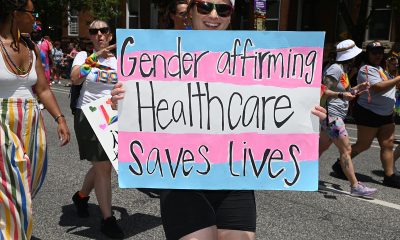National
New York Times called out for coverage of transgender people
GLAAD billboard circled newspaper’s Manhattan headquarters on Wednesday morning
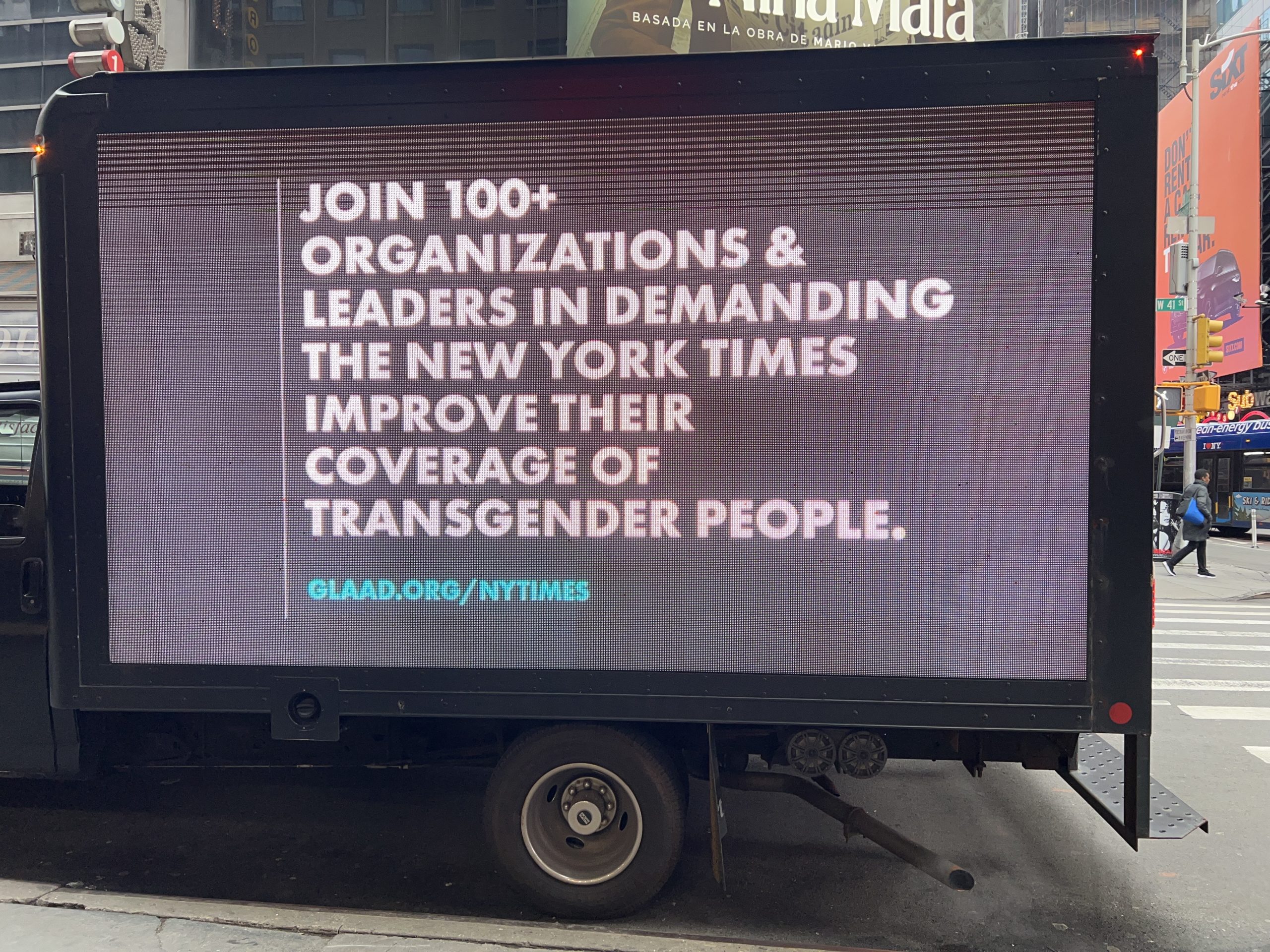
In a one-two punch aimed directly at the New York Times; more than 100 contributing writers, fellow journalists, celebrities and advocacy organizations today joined GLAAD in demanding change in how the newspaper covers transgender issues and trans people.
First, GLAAD hired a billboard truck to circle the newspaper’s Manhattan headquarters this morning with signs saying, “Dear New York Times: Stop questioning trans people’s right to exist and access to medical care,” among other messages.
“I think what what’s most upsetting here is the damage this is doing,” Sarah Kate Ellis, GLAAD CEO and president of the world’s largest LGBTQ media advocacy organization, told the Washington Blade in her first phone interview on the topic Tuesday. “Every day they’re not stopping is doing more damage. Every time a new article comes out that debates whether or not trans people should receive board-approved healthcare is damaging. And so I feel really strongly that their coverage is dangerous.”
Then, to protest what GLAAD calls the Times’ “irresponsible, biased coverage of transgender people,” representatives of the organization joined contributors for the Times outside the paper’s building this morning, as they delivered two open letters and issued a joint statement, calling out a “pattern of inaccurate, harmful trans coverage.”
The coalition demands the Times immediately “stop printing biased, anti-trans stories,” meet with members and leaders in the trans community within two months, and within three months hire at least four trans writers and editors as full-time members of the Times staff.
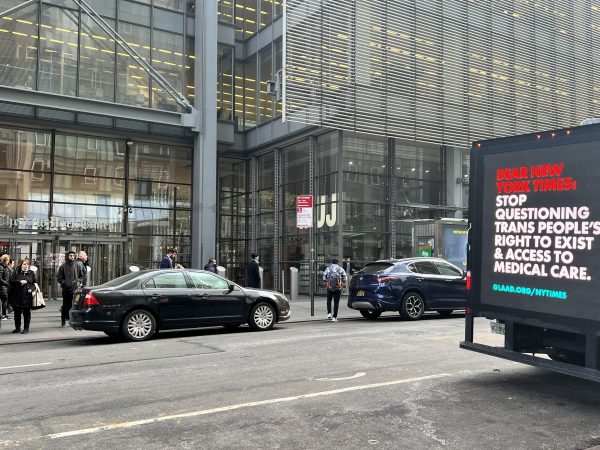
Joining GLAAD are the Human Rights Campaign, PFLAG, the Transgender Law Center, Transgender Legal Defense and Education Fund, the Women’s March, director Judd Apatow, comedian Margaret Cho, actor Wilson Cruz, actresses Tommy Dorfman, Lena Dunham, Jameela Jamil, drag superstar Peppermint, activist Ashlee Marie Preston, Jeopardy! champion Amy Schneider, writer/director/actress Shakina, actress, Instagram influencer and stepmom to Zaya, Gabrielle Union-Wade, TV personality Jonathan Van Ness, activist Charlotte Clymer and more.
“This has been an effort at GLAAD for over a year now,” Ellis told the Blade. “We’ve had several off-the-record meetings with the New York Times to share with them our concerns about the coverage and the reporting that they’ve been doing on the trans community.”
But those concerns fell on deaf ears, said Ellis, and the conversations were unfruitful. “We wouldn’t be going out with a public letter in coalition if they were fruitful. You know, for us going public, it’s always the last resort.”
Times Journalists Speak Out
As GLAAD worked toward publishing its letter, the organization was contacted by Times contributors already in the process of composing their own. A core team of eight journalists collaborated to condemn what they called the newspaper’s anti-trans bias and the real-world impact of that transphobic coverage.
The authors are Times freelancers Harron Walker, Eric Thurm, who is also campaigns coordinator at the National Writers Union and a steering committee member of the Freelance Solidarity Project, Sean T. Collins, who is also a member and organizer of the Freelance Solidarity Project, Cecilia Gentili, a longtime trans activist, Jo Livingstone, Muna Mire, and Chris Randle, a member of the steering committee at the Freelance Solidarity Project.
They were joined by Olivia Aylmer, a member of the steering committee at the Freelance Solidarity Project who is not a freelancer for the Times.
Not only did other contributing writers sign-on, but so did journalism colleagues, both cisgender and trans, as well as members of the Trans Journalists Association.
“A diverse group of people came together to bring you this complaint,” they wrote. ”Some of us are trans, nonbinary, or gender nonconforming, and we resent the fact that our work, but not our person, is good enough for the paper of record. Some of us are cis, and we have seen those we love discover and fight for their true selves, often swimming upstream against currents of bigotry and pseudoscience fomented by the kind of coverage we here protest.”
Those signing that letter include Ashley P. Ford, Roxane Gay, Carmen Maria Machado Thomas Page McBee, Andrea Long Chu, Carmen Maria Machado, John Cameron Mitchell, Zach Stafford, Raquel Willis and Maia Monet, among others.
Their letter, addressed directly to Times Standards Editor Philip Corbett, calls out the country’s third most-read paper for executing what it says is “poor editorial judgment,” repeated lack of context in its reporting on trans issues and following “the lead of far-right hate groups in presenting gender diversity as a new controversy, warranting new, punitive legislation.”
“There is in fact an unethical bias against trans people and transnesss within its coverage of trans issues, by and large,” said Walker, one of the organizers of the contributors’ letter. “There is a pattern of bias, and it’s a violation of the standards own policy as laid out by the standards desk.”
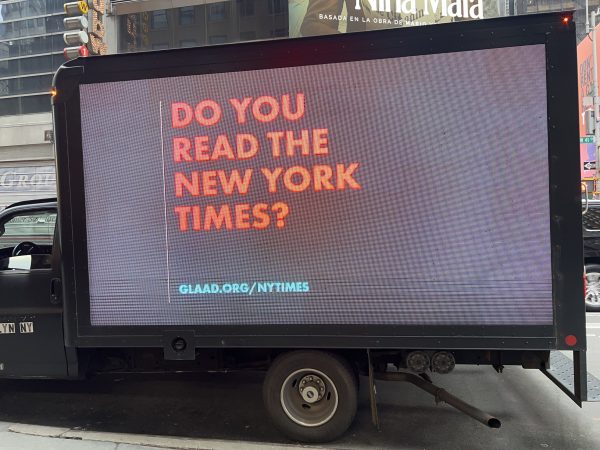
States that have seized upon this anti-trans reporting and opinion pieces by the Times include Alabama, Arkansas and Texas. Already, those states have joined Florida, Oklahoma, South Dakota, Tennessee and Utah in enacting discriminatory legislation.
Of these, Utah and South Dakota have passed healthcare bans that journalist Erin Reed calls “exceedingly cruel.” For example, South Dakota’s ban is one of those providing specific provisions on how to medically detransition trans teenagers, a practice now state law in Alabama and Arkansas.
“The New York Times coverage is feeding into defending these laws, by virtue of the fact that it’s the so-called paper of record,” Walker told the Blade. “It has one of the largest reaches of any newspaper in the world, it is respected. Even if people on the far right may dismiss it as the ‘failing New York Times,’ it still holds a legitimacy in a process that, you know, means something.”
‘Pattern of bias’
“Plenty of reporters at the Times cover trans issues fairly,” the contributing writers’ letter states. “Their work is eclipsed, however, by what one journalist has calculated as over 15,000 words of front-page Times coverage, debating the propriety of medical care for trans children published in the last eight months alone.”
GLAAD notes that officials in Texas quoted Emily Bazelon’s June 2022 report to go after families of trans youth in court documents over their private, evidence-based healthcare decisions.
Former Arkansas Attorney General Leslie Rutledge cited three Times articles in her amicus brief supporting an Alabama law that criminalizes doctors and parents for ensuring trans youth can access necessary medical care: Bazelon’s 2022 story, Azeen Ghorayshi’s January 2022 piece, and Ross Douthat’s April 2022 op-ed.
The Times’ reporting on trans youth and its reputation as the “paper of record” was cited just last week to justify a bill in a Nebraska legislative hearing, that would criminalize healthcare for trans youth.
Scores of other bills are in the works. Missouri Republicans are once again pushing for healthcare bans. Anti-trans bills in Montana, West Virginia and Mississippi have passed an entire chamber.
But by far the worst anti-transgender legislation and existing laws against the trans community are already on the books in Texas, which Reed calls “home to the weaponization of [Department of Protective Family Services] against transgender people.”
New restrictive bathroom laws are in place in Oklahoma, Alabama and Tennessee. Oklahoma’s healthcare ban restricts even adults, up to the age of 26, from accessing gender-affirming care. Florida has banned Medicaid coverage for trans-related healthcare for adults and is banning gender affirming care for trans teens. And as mentioned earlier, Utah, South Dakota, Arkansas and Alabama have targeted trans teens as well.
‘Britification’ of American media
For the most part over the last two decades, U.S. media had reliably shared a positive view of transgender people, especially youth, highlighting the stories of out trans celebrities like Chaz Bono, Laverne Cox, Caitlyn Jenner and Jazz Jennings. But since the Obergefell decision at the U.S. Supreme Court in 2015, trans people have become the religious right’s handy-dandy political boogeyman, to scare the flocks, rally the base and get out the vote. That’s a shift that was preceded by all-out negative coverage of trans issues in the U.K., where with rare exception the mainstream media is in lockstep with what is called the “Gender Critical” movement, opposing trans rights.
Ari Drennen is the LGBTQ program director for Media Matters, and has been tracking coverage of trans issues at the Times.
“I think it’s good to see people speaking up and talking about the really troubling pattern of coverage coming out of the Times, just because the Times is seen as the kind of gold standard for a lot of mainstream liberals,” Drennen told the Blade. “That pattern is especially notable at the Times. But there has been a sort of, you know, Britification, for lack of a better word, of the American media’s approach to trans people.”
Drennen cites a Reuters article from October about gender-affirming care for trans children that featured an extreme close-up photograph of a child wearing braces with a hormone pill on their tongue. “That was really just clearly intended to scare parents,” she said.
Also keeping a close watch on the Times and this Britification effect is Alejandra Caraballo, a clinical instructor at Harvard Law School’s Cyberlaw Clinic, where she works to advance the civil rights of LGBTQ people in a variety of civil legal contexts such as healthcare access, immigration and family law.
“In the U.K., the far right, particularly the religious far right, is almost a non-entity. They just don’t have the kind of cultural power and political power that they do in the United States,” Caraballo told the Blade, noting that the Gender Critical movement has taken a a more secular approach to its opposition to trans people, rather than a religious angle.
“In the United States, it’s always been the religious far right, but they are now trying to launder those narratives through these kind of secular outlets, to try to make it seem that the concerns aren’t just inherently based on religious ideology,” she said. “Part of it is this concerted strategy that I think a lot of the Gender Criticals have of particularly appealing to narratives that upper middle class white women would often be more amenable to, especially this idea that women have fought for rights, and somehow the existence of trans people is undermining those rights, because it’s hard to just oppose rights for people if it doesn’t impact you, so you have to create a sense of scarcity, and that’s what they do there. They say that ‘This is erasing women,’ ‘This is erasing women’s rights.’”
Racial bias
Caraballo noted that the people who are writing these stories at the Times are almost universally upper middle class, middle-aged white women, which speaks to the lack of racial diversity at the newspaper.
“I think what’s interesting is the kind of subject of every panic about over-medicalization in mainstream media tend to be white, and then the subject of the panic about kids and sports tend to be Black,” said Drennen. “I don’t need to have a Ph.D to see what’s going on.”
“I think part of it speaks to the lack of racial diversity,” echoed Caraballo. “I’m not surprised that one of the first really positive, outspoken editorials in the opinion column in the New York Times was by a Black man. I think there’s a sense of solidarity and understanding of how these things work, and I think when you have no trans people in the newsroom and no trans people as opinion columnists, and you have a newsroom that’s almost entirely stocked with a demographic that is particularly being targeted by Gender Criticals for pushing their views. I think it’s not a surprise.”
Anti-trans agenda
Caraballo said her conversations with people who work at the Times leads her to suspect this shift toward anti-trans narratives is not the writers or reporters themselves, but the result of an agenda set by their editors.
“For some people like Katie J.M. Baker, who has written extensively about how the media actually works to push transphobic narratives, to then write an article like she did about forcibly outing trans students, it just speaks to either opportunism, not really having a deeply-held belief about this, or just being pushed by the editors. I mean, this was her first major story,” she said. “I worry that what happens is the New York Times often times gives those kinds of views credibility. And you see this with the anti-trans people celebrating every one of these articles, because they view that they’re trans eliminationist and anti-trans positions are being laundered into the mainstream.”
Anti-trans tipping point
In 2014, Time Magazine put Laverne Cox on its cover and declared that trans Americans had achieved a tipping point in acceptance. But at the Times, a shift in who writes opinion pieces has tipped the balance the other way, noted Drennen.
“The New York Times has never been perfect in their coverage, of course. But over the last year, Jennifer Finney Boylan departed from the Times’s opinion section,” she said. While Boylan is still a freelancer for the Times, the bestselling author and scholar’s byline now regularly appears in the Washington Post.
“In the interim, they’ve added two incredibly anti-trans regular columnists, Pamela Paul and David French, the former lawyer for the anti-LGBTQ+ hate group, the Alliance Defending Freedom. This has a really troubling pattern of anti-trans sentiment. So, any perceived balance there was just got totally blown out the window over the last year.”
“I’m proud of the work I did for Times Opinion from 2007 to 2022, on hundreds of topics from presidential dogs to the history of the Negroni,” Boylan told the Blade. “As a freelancer, I felt lucky to have a regular slot on the page and was grateful for the trust the editors placed in me. I also wrote many essays about trans identity and trans politics, and was proud to be, for many years, the only ongoing voice on the page representing the wide range of trans identities. I am hoping all those stories put a human face to trans issues for readers of the Times, and opened some hearts.”
Boylan’s name does not appear alongside other Times freelancers in the open letter or the GLAAD letter, but ironically, the Times has been publishing her name in its Bestsellers list for 18 weeks in a row. Her novel, Mad Honey, co-written with Jodi Picoult, has yet to be reviewed in the newspaper or covered in any way, despite it being the most successful book co-written by any transgender person, ever. Is that more evidence of bias, or just a coincidence?
The science ‘debate’
“I am really disappointed that it’s come to this,” said Ellis. “The science is settled on transgender health care. As far as the New York Times is concerned, it is not settled science and they want to use their pages to debate it.”
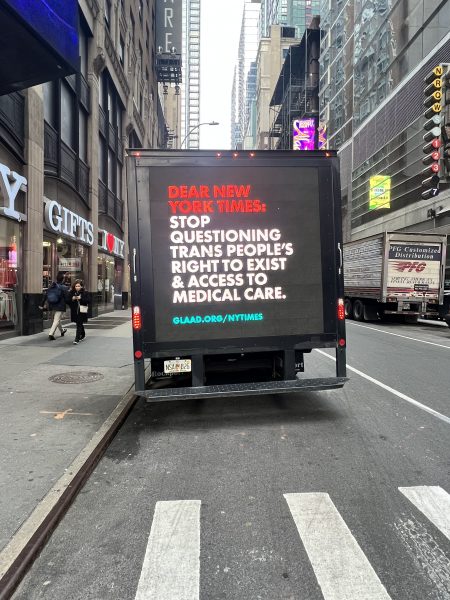
“It’s so dehumanizing,” added Caraballo, “because you have people debating your rights who have no stake in it whatsoever. They’re not the ones that are going to be denied healthcare. They’re not the ones who are going to be denied housing. They’re not the ones who are going to be kicked out of their homes when they’re forcibly outed to their parents. They have no stake in this. And that is particularly what’s so upsetting, to see all these people that literally will never feel the effects of these policies, constantly talking about how they have ‘concerns.’”
Will the Times agree to their demands?
Drennen said it’s hard to say whether these open letters will have any impact, because “so much of their decision-making is internal.”
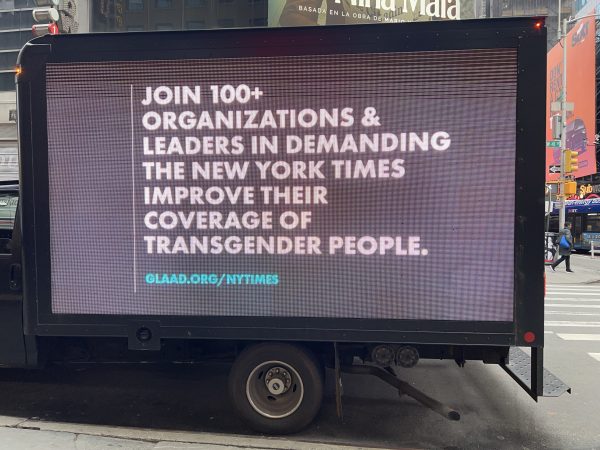
For her part, Walker said she remains excited by the coalition that’s been assembled and optimistic, but also realistic.
“Ideally what happens is the New York Times says, ‘Okay, yeah, let’s stop debating whether trans people should be allowed,’ and they start hiring a bunch of trans people. It’s the end of the story. I’m also realistic. I think it’s important to keep some idealism and some optimism in place and also realistic at the same time, which I also think is important. And I fully expect them to do their best to ignore it.”
“We’re too loud to ignore. If you ignore our letter, we’ll find some other way. If you ignore that, we’ll find another way,” Ellis said. “We’re not going to quit until the New York Times acknowledges our demands. And our demands are not outrageous. Within the letter, we’re just talking about stopping your irresponsible reporting, meeting with the trans community and hiring trans writers and editors. These are not outrageous demands that we’re making.”
Charlie Stadtlander, the director of external communications, newsroom, for the Times responded Wednesday afternoon in an email to the Blade addressing the controversy:
“We received the open letter delivered by GLAAD and welcome their feedback. We understand how GLAAD and the co-signers of the letter see our coverage. But at the same time, we recognize that GLAAD’s advocacy mission and the Times’s journalistic mission are different.
As a news organization, we pursue independent reporting on transgender issues that include profiling groundbreakers in the movement, challenges and prejudice faced by the community, and how society is grappling with debates about care.
The very news stories criticized in their letter reported deeply and empathetically on issues of care and well-being for trans teens and adults. Our journalism strives to explore, interrogate and reflect the experiences, ideas and debates in society — to help readers understand them. Our reporting did exactly that and we’re proud of it.”
Read the letters and who signed them by clicking here.
National
US bishops ban gender-affirming care at Catholic hospitals
Directive adopted during meeting in Baltimore.

The U.S. Conference of Catholic Bishops this week adopted a directive that bans Catholic hospitals from offering gender-affirming care to their patients.
Since ‘creation is prior to us and must be received as a gift,’ we have a duty ‘to protect our humanity,’ which means first of all, ‘accepting it and respecting it as it was created,’” reads the directive the USCCB adopted during their meeting that is taking place this week in Baltimore.
The Washington Blade obtained a copy of it on Thursday.
“In order to respect the nature of the human person as a unity of body and soul, Catholic health care services must not provide or permit medical interventions, whether surgical, hormonal, or genetic, that aim not to restore but rather to alter the fundamental order of the human body in its form or function,” reads the directive. “This includes, for example, some forms of genetic engineering whose purpose is not medical treatment, as well as interventions that aim to transform sexual characteristics of a human body into those of the opposite sex (or to nullify sexual characteristics of a human body.)”
“In accord with the mission of Catholic health care, which includes serving those who are vulnerable, Catholic health care services and providers ‘must employ all appropriate resources to mitigate the suffering of those who experience gender incongruence or gender dysphoria’ and to provide for the full range of their health care needs, employing only those means that respect the fundamental order of the human body,” it adds.
The Vatican’s Dicastery for the Doctrine of the Faith in 2024 condemned gender-affirming surgeries and “gender theory.” The USCCB directive comes against the backdrop of the Trump-Vance administration’s continued attacks against the trans community.
The U.S. Supreme Court in June upheld a Tennessee law that bans gender-affirming medical interventions for minors.
Media reports earlier this month indicated the Trump-Vance administration will seek to prohibit Medicaid reimbursement for medical care to trans minors, and ban reimbursement through the Children’s Health Insurance Program for patients under 19. NPR also reported the White House is considering blocking all Medicaid and Medicare funding for hospitals that provide gender-affirming care to minors.
“The directives adopted by the USCCB will harm, not benefit transgender persons,” said Francis DeBernardo, executive director of New Ways Ministry, a Maryland-based LGBTQ Catholic organization, in a statement. “In a church called to synodal listening and dialogue, it is embarrassing, even shameful, that the bishops failed to consult transgender people, who have found that gender-affirming medical care has enhanced their lives and their relationship with God.”

President Donald Trump on Wednesday signed a bill that reopens the federal government.
Six Democrats — U.S. Reps. Jared Golden (D-Maine), Marie Gluesenkamp Perez (D-Wash.), Adam Gray (D-Calif.), Don Davis (D-N.C.), Henry Cuellar (D-Texas), and Tom Suozzi (D-N.Y.) — voted for the funding bill that passed in the U.S. House of Representatives. Two Republicans — Thomas Massie (R-Ky.) and Greg Steube (R-Fla.) — opposed it.
The 43-day shutdown is over after eight Democratic senators gave in to Republicans’ push to roll back parts of the Affordable Care Act. According to CNBC, the average ACA recipient could see premiums more than double in 2026, and about one in 10 enrollees could lose a premium tax credit altogether.
These eight senators — U.S. Sens. Catherine Cortez Masto (D-Nev.), Dick Durbin (D-Ill.), John Fetterman (D-Pa.), Maggie Hassan (D-N.H.), Tim Kaine (D-Va.), Angus King (I-Maine), Jacky Rosen (D-Nev.), and Jeanne Shaheen (D-N.H.) — sided with Republicans to pass legislation reopening the government for a set number of days. They emphasized that their primary goal was to reopen the government, with discussions about ACA tax credits to continue afterward.
None of the senators who supported the deal are up for reelection.
King said on Sunday night that the Senate deal represents “a victory” because it gives Democrats “an opportunity” to extend ACA tax credits, now that Senate Republican leaders have agreed to hold a vote on the issue in December. (The House has not made any similar commitment.)
The government’s reopening also brought a win for Democrats’ other priorities: Arizona Congresswoman Adelita Grijalva was sworn in after a record-breaking delay in swearing in, eventually becoming the 218th signer of a discharge petition to release the Epstein files.
This story is being updated as more information becomes available.
U.S. Military/Pentagon
Serving America, facing expulsion: Fight for trans inclusion continues on Veterans Day
Advocates sue to reverse Trump ban while service members cope with new struggles

President Trump signed EO 14183, titled “Prioritizing Military Excellence and Readiness,” on Jan. 27, directing the Department of Defense (DoD) to adopt policies that would prohibit transgender, nonbinary, and gender-nonconforming people from serving in the military.
The Trump-Vance administration’s policy shift redefines the qualifications for military service, asserting that transgender people are inherently incapable of meeting the military’s “high standards of readiness, lethality, cohesion, honesty, humility, uniformity, and integrity,” citing a history or signs of gender dysphoria. According to the DoD, this creates “medical, surgical, and mental health constraints on [an] individual.” Regardless of their physical or intellectual capabilities, transgender applicants are now considered less qualified than their cisgender peers.
On Jan. 28, 2025, GLBTQ Legal Advocates and Defenders (GLAD) Law and the National Center for LGBTQ Rights (NCLR) filed Talbott v. Trump, a federal lawsuit in the U.S. District Court for the District of Columbia challenging the executive order. Originally filed on equal protection grounds on behalf of six active service members and two individuals seeking enlistment, the case has since grown to include 12 additional plaintiffs.
The Washington Blade spoke exclusively with Second Lt. Nicolas (Nic) Talbott, U.S. Army, a plaintiff in the case, and with Jennifer Levi, Senior Director of Transgender and Queer Rights at GLAD Law, who is leading the litigation.
For Talbott, serving in the military has been a lifelong aspiration, one he pursued despite the barriers posed by discriminatory policies.
“Being transgender posed quite the obstacle to me achieving that dream,” Talbott told the Blade. “Not because it [being trans] had any bearing on my ability to become a soldier and meet the requirements of a United States soldier, but simply because of the policy changes that we’ve been facing as transgender service members throughout the course of the past decade… My being transgender had nothing to do with anything that I was doing as a soldier.”
This drive was fueled by early life experiences, including the impact of the Sept. 11 terrorist attacks, which shaped his desire to protect his country.
“Even for an eight-year-old kid, [9/11] has a tremendous amount of impact… I remember thinking, you know, this is a terrible thing. Me, and when I grow up, I want to make sure nothing like this ever happens again,” he said. “I’ve still tried to gear my life in a way that I can be preparing myself to eventually help accomplish that mission of keeping America safe from anything like that ever happening again.”
The attacks inspired countless Americans to enlist; according to the New York City government, 181,510 joined active duty and 72,908 enlisted in the reserves in the year following 9/11. Although Talbott was too young to serve at the time, the events deeply influenced his educational and career path.
“For me, [9/11] just kind of helped shape my future and set me on the path that I’m currently on today,” he added. “It ignited my passion for the field, and it’s something that you know, I’ve carried with me into my adult life, into my professional life, and that I hope to have a career in the future.”
Talbott holds a master’s degree in criminology with a focus on counterterrorism and global security, and while completing his degree, he gained practical experience working with the Transportation Security Administration.
Despite the public scrutiny surrounding the lawsuit and the ongoing uncertainty of his military future, Talbott remains grounded in the values that define military service.
“Being so public about my involvement with this lawsuit grants me the very unique opportunity to continue to exemplify those values,” Talbott said. “I’m in a very privileged spot where I can speak relatively openly about this experience and what I’m doing. It’s very empowering to be able to stand up, not only for myself, but for the other transgender service members out there who have done nothing but serve with honor and dignity and bravery.”
The ban has created significant uncertainty for transgender service members, who now face the possibility of separation solely because of their gender identity.
“With this ban… we are all [trans military members] on track to be separated from the military. So it’s such a great deal of uncertainty… I’m stuck waiting, not knowing what tomorrow might bring. I could receive a phone call any day stating that the separation process has been initiated.”
While the Department of Defense specifies that most service members will receive an honorable discharge, the policy allows for a lower characterization if a review deems it warranted. Compensation and benefits differ depending on whether service members opt for voluntary or involuntary separation. Voluntary separation comes with full separation pay and no obligation to repay bonuses, while involuntary separation carries lower pay, potential repayment of bonuses, and uncertain success in discharge review processes.
Healthcare coverage through TRICARE continues for 180 days post-discharge, but reduced benefits, including VA eligibility, remain a concern. Those with 18–20 years of service may qualify for early retirement, though even this is not guaranteed under the policy.
Talbott emphasized the personal and professional toll of the ban, reflecting on the fairness and capability of transgender service members.
“Quite frankly, the evidence that we have at hand points in the complete opposite direction… there are no documented cases that I’m aware of of a transgender person having a negative impact on unit cohesion simply by being transgender… Being transgender is just another one of those walks of life.”
“When we’re losing thousands of those qualified, experienced individuals… those are seats that are not just going to be able to be filled by anybody … military training that’s not going to be able to be replaced for years and years to come.”
Talbott also highlighted the unique discipline, dedication, and value of diversity that transgender service members bring—especially in identifying problems and finding solutions, regardless of what others think or say. That, he explained, was part of his journey of self-discovery and a key reason he wants to continue serving despite harsh words of disapproval from the men leading the executive branch.
“Being transgender is not some sad thing that people go through… This is something that has taken years and years and years of dedication and discipline and research and ups and downs to get to the point where I am today… my ability to transition was essential to getting me to that point where I am today.”
He sees that as an asset rather than a liability. By having a more diverse, well-rounded group of people, the military can view challenges from perspectives that would otherwise be overlooked. That ability to look at things in a fresh way, he explained, can transform a good service member into a great one.
“I think the more diverse our military is, the stronger our military is… We need people from all different experiences and all different perspectives, because somebody is going to see that challenge or that problem in a way that I would never even think of… and that is what we need more of in the U.S. military.”
Beyond operational effectiveness, Talbott emphasized the social impact of visibility and leadership within the ranks. Fellow soldiers often approached him for guidance, seeing him as a trusted resource because of his transgender status.
“I can think of several instances in which I have been approached by fellow soldiers… I feel like you are a person I can come to if I have a problem with X, Y or Z… some people take my transgender status and designate me as a safe person, so to speak.”
With the arrival of Veterans Day, the Blade asked what he wishes the public knew about the sacrifices of transgender service members. His answer was modest.
“Every person who puts on the uniform is expected to make a tremendous amount of sacrifice,” Talbott said. “Who I am under this uniform should have no bearing on that… We shouldn’t be picking and choosing which veterans are worthy of our thanks on that day.”
Jennifer Levi, GLAD Law’s Senior Director of Transgender and Queer Rights, also spoke with the Blade and outlined the legal and human consequences of the ban. This is not Levi’s first time challenging the executive branch on transgender rights; she led the legal fight against the first Trump administration’s military ban in both Doe v. Trump and Stockman v. Trump.
Levi characterized the policy as overtly cruel and legally indefensible.
“This policy and its rollout is even more cruel than the first in a number of ways,” Levi explained. “For one, the policy itself says that transgender people are dishonest, untrustworthy and undisciplined, which is deeply offensive and degrading and demeaning.”
She highlighted procedural abuses and punitive measures embedded in the policy compared to the 2017 ban.
“In the first round the military allowed transgender people to continue to serve… In this round the military policy purge seeks to purge every transgender person from military service, and it also proposes to do it in a very cruel and brutal way, which is to put people through a process… traditionally reserved for kicking people out of the military who engaged in misconduct.”
Levi cited multiple examples of discrimination, including the revocation of authorized retirements and administrative barriers to hearings.
She also explained that the administration’s cost argument is flawed, as removing and replacing transgender service members is more expensive than retaining them.
“There’s no legitimate justification relating to cost… it is far more expensive to both purge the military of people who are serving and also to replace people… than to provide the minuscule amount of costs for medications other service members routinely get.”
On legal grounds, Levi noted the ban violates the Equal Protection Clause.
“The Equal Protection Clause prevents laws that are intended to harm a group of people… The doctrine is rooted in animus, which means a bare desire to harm a group is not even a legitimate governmental justification.”
When asked what she wishes people knew about Talbott and other targeted transgender military members, Levi emphasized their extraordinary service.
“The plaintiffs that I represent are extraordinary… They have 260 years of committed service to this country… I have confidence that ultimately, this baseless ban should not be able to legally survive.”
Other organizations have weighed in on Talbott v. Trump and similar lawsuits targeting transgender service members.
Human Rights Campaign Foundation President Kelley Robinson criticized the ban’s impact on military readiness and highlighted the counterintuitive nature of removing some of the country’s most qualified service members.
“Transgender servicemembers serve their country valiantly, with the same commitment, the same adherence to military standards and the same love of country as any of their counterparts,” Robinson said. “This ban by the Trump administration, which has already stripped transgender servicemembers of their jobs, is cruel, unpatriotic, and compromises the unity and quality of our armed forces.”
Lambda Legal Senior Counsel Sasha Buchert echoed the legal and moral imperative to reverse the policy.
“Every day this discriminatory ban remains in effect, qualified patriots face the threat of being kicked out of the military,” she said. “The evidence is overwhelming that this policy is driven by animus rather than military necessity… We are confident the court will see through this discriminatory ban and restore the injunction that should never have been lifted.”
-

 U.S. Supreme Court3 days ago
U.S. Supreme Court3 days agoSupreme Court rejects Kim Davis’s effort to overturn landmark marriage ruling
-

 District of Columbia3 days ago
District of Columbia3 days agoCapital Pride files anti-stalking complaint against local LGBTQ activist
-

 Movies5 days ago
Movies5 days agoSuperb direction, performances create a ‘Day’ to remember
-

 Theater4 days ago
Theater4 days agoAstounding ‘LIZZIE’ builds on legendary axe murder tale

